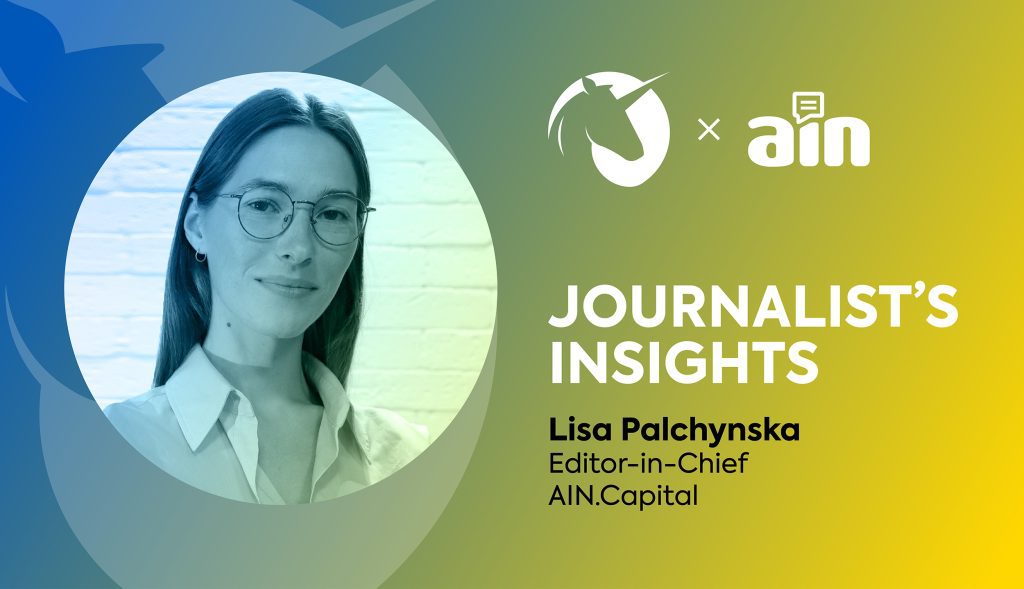Unless you have been living under a rock, you will know that the CEE startup scene is taking off, fast. Numerous reports by the likes of Dealroom, but also from VCs like Change Ventures and others are all providing proof of that. One of the things these reports all have in common is they highlight the above-average speed of the region’s development and the huge opportunities that it provides (as well as other facts and metrics that put them even above more mature startup markets).
The rise of Central and Eastern European startups is also reflected in new media outlets capturing the stories behind the funds raised, behind the products launched, and behind the births of unicorns in the region. One of those outlets, and perhaps the only one to focus on and unify the entire CEE region, is AIN.Capital, based in Kyiv.
We couldn’t miss out on the opportunity to ask Lisa Palchynska, AIN.Capital’s new Editor-in-Chief, a few questions. We cover the growth of the outlet, what it is like working out of Ukraine in the middle of a war, and some of her insights for us PR folks out there. Lisa also shed light on some of their investigative reporting, such as the time when they helped revoke SLUSH’s award to a Russia-linked startup, or their reporting on the pro-Russia video game Atomic Heart.
Part I: AIN.Capital, Lisa’s role and background
BUPR: Could you introduce AIN.Capital for those that may have not come across it yet?
AIN.Capital is a part of a Ukrainian media group of three outlets that together have up to 3 million pageviews monthly. The group includes:
- AIN.UA, the main tech media in Ukraine covering the local tech industry, startup and VC scene since 1999;
- AIN.Business, focused on Ukrainian small and medium-sized businesses,
- AIN.Capital, a media outlet that was created following the example of AIN.UA, but not limiting itself to Ukraine; instead, it covers the startup and VC ecosystem across Central and Eastern Europe. We publish news, stories, and interesting cases from this region’s tech scene, and we are currently preparing comprehensive rankings and reports on it.
BUPR: Tell us more about your role at AIN.Capital.
Lisa: In short, I am responsible for our media product growth and building the AIN.Capital brand in CEE markets. This includes managing AIN.Capital content, ensuring its credibility, leading day-to-day operations, and establishing joint projects with major ecosystem players.
BUPR: We were aware of AIN.UA’s Ukraine coverage, but noticed that English content was not a main focus before. AIN.Capital’s coverage has expanded tremendously. What is the background story to that?
Lisa: AIN.Capital is the media product developed by the team of AIN.UA. And, initially, AIN.UA had an English version with Ukraine-focused content for international audiences. At the end of 2021, we decided to expand our expertise to cover the whole CEE region. This strategy worked, and we got both more readers and positive feedback from the region’s ecosystem players.
We also have seen that CEE still remains terra incognita, unlike the already established tech hubs like the US, the UK, Israel, Singapore etc. — despite CEE being the home of great tech startups and companies, whose products have been used worldwide for a long time. Following the mission to change this state of things, we launched a separate, fully-fledged media product dedicated to CEE called AIN.Capital.
When the full-scale war began, we suspended writing about CEE for a few months and focused on articles about Ukraine. Starting from May 2022, AIN.Capital returned to its initial strategy.
BUPR: What is your background and what steps led you to become AIN.Capital new Editor-in-Chief?
Lisa: I intended to build a professorial career in History somewhere in Germany. But things happened differently. While studying, I was invited to AIN.UA as a contributing editor. Some years later, already with experience as project manager at local cultural and foreign diplomatic institutions, I joined AIN.UA team as a staff editor. As international communication is kind of my passion, I have been entrusted to lead AIN.Capital.
Part II: Ukraine tech and the war
BUPR: What is it like working at AIN.UA and AIN.Capital currently?
Lisa: Starting from February 24, the whole editorial team of our media group has not suspended its work for a single day. Instead, from the very beginning, we have shifted our focus to covering the full-scale war launching daily digests of key events in Ukraine provided by the Editor-in-Chief of AIN.UA Illia Kabachynskyi, collecting stories of Ukrainian startups and VCs going through the wartimes, and conducting investigations on businesses operating in Russia.
And to this day, we write about how the tech ecosystem is overcoming all the war challenges, publishing the interviews with IT specialists and tech entrepreneurs who joined the Armed Forces, replacing their laptops with weapons and drones.
Talking about investigative journalism, facts are being constantly uncovered by our editorial staff, becoming powerful arguments used by the Ukrainian government and members of the tech PR community in discussions regarding the necessity of sanctions. One of the most recent examples is our series of articles on Atomic Heart, a game developed by Russian studio Mundfish.
At the same time, despite facing numerous challenges amid the ongoing war, AIN.UA and AIN.Capital continue to grow fast. In particular, since the full-fledged launch of AIN.Capital in May of last year, we have expanded our team and increased the traffic of this media product threefold.
BUPR: Last year, the biggest European event for startups, Slush, controversially awarded a Russian team their yearly award. AIN.Capital was the first to investigate and report, and eventually the decision was overturned. Can you walk us through how you did it?
Lisa: I came across a LinkedIn post by Yaroslav Krempovych, Senior Associate at Movens Capital, announcing that Immigram, UK-based startup with a team in Russia, had won the Slush 100 Pitching Competition. Since I knew nothing about the startup, I began researching to gather more information.
During the research, I discovered that Immigram was operating in Russia and still hiring people in Moscow, which was a clear violation of Slush rules. So early in the Saturday morning I published an article on AIN.Capital with all the evidence, and it caused a wave of logical questions that reached the Slush organizers. A significant contribution was also made by the Ukrainian PR army. The result is well known, Slush apologized and revoked the prize.
BUPR: Where do you see Ukrainian tech going in the next few years? From outside, it looks like a highly resilient, high people potential startup nation with a promising future.
Lisa: When we look at the general trends, we see that product companies have experienced a boost, while the demand for outsourcing services has decreased. As for the product directions, Military Tech and Cybersecurity, among others, are expected to shape the future of the Ukrainian tech scene.
Ukraine is currently engaged in the most technologically advanced war in history, and our country is managing to stay ahead in the use of innovative military technologies. Particularly, we are now witnessing a surge in domestic drone production due to their crucial role in the battlefield. In the last six months alone, the number of Ukrainian companies producing UAVs has increased by more than five times, pointing to the potential for further growth in this direction.
AgroTech and HealthTech have also seen an increase in popularity and are expected to become demanded verticals for development in Ukraine.
BUPR: If people want to help Ukraine, be it financial support or other, what would you recommend they do?
Lisa: I would recommend donating to Ukrainian reputable and trustworthy organizations, such as Come Back Alive, UNITED24, KOLO. Also, one way to bolster Ukraine’s economy and people is to support local businesses by purchasing their products and services. Finally, raising awareness about the ongoing war in Ukraine is still crucial, and can involve sharing information on social media or participating in advocacy efforts to urge political leaders to take action.
PART III: Tips for PR folks
BUPR: How many press releases do you get every day?
Lisa: On average, around 100 daily.
BUPR: What is your biggest “pet peeve” when it comes to PR professionals, whether from startups in-house or agencies?
Lisa: Sometimes we receive information on the topics totally irrelevant for AIN.Capital, which are then followed by more emails or, even worse, DMs on LinkedIn with “Have you any chance to look at the press release I sent you? :)” and similar variations of the question. 99% of the time we will ignore such conversations. Sorry!
And the most simple truth about journalists is that we do like facts and numbers. So emails full of general statements like “our technology is unique, which is to make our product undoubtedly perfect itself” will definitely make us roll our sad eyes and skip this information as well.
Have you seen the rest of our blog yet? Here is more from our Journalist’s Insights series:
Busting Journalism Myths with Lindsay Dodgson from Business Insider
Diving into fintech journalism with Doug Mackenzie from Fintech Finance
Securing media placements during COVID-19 with Yessi Bello-Perez from The Next Web
Journalist’s Insights: From PR to Media With Remco Janssen of Silicon Canals
Connecting the European startup scene with Patricia Allen of EU-Startups



